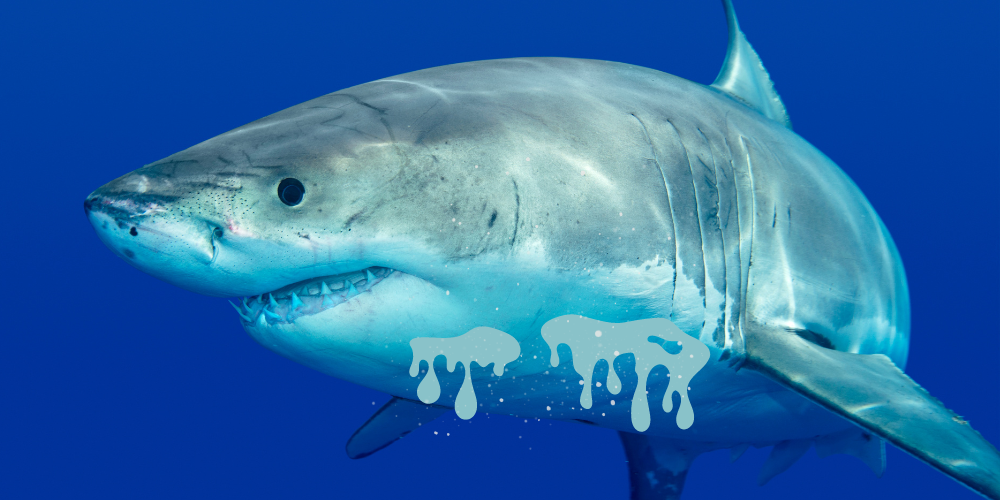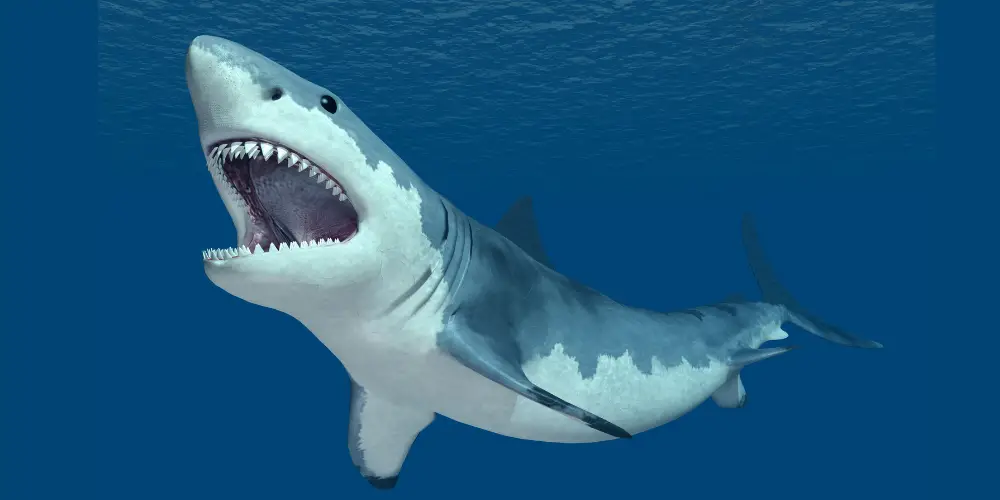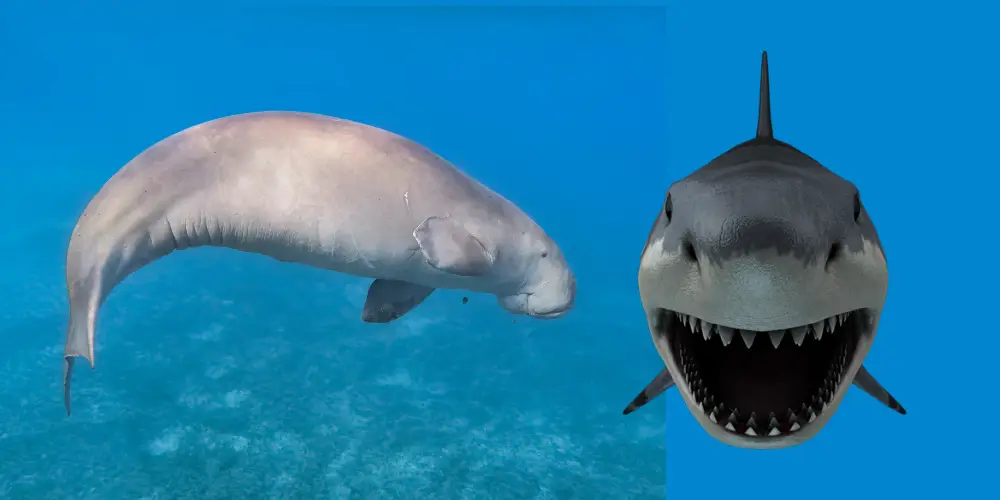Sharks have a reputation for their impressive predatory skills, but did you know they have a distinct way of eliminating waste from their bodies? Welcome to the fascinating world of shark physiology!
In this blog post, we will debunk myths, dispel misunderstandings, and unveil the truth about whether sharks do pee through their skin.
Sharks “pee” through their skin. They retain urea in their bloodstream to maintain osmotic balance with the salty ocean water. The excess urea is diffused through their skin and gills, often described as sharks “peeing” through their skin.
Key Takeaways
- Sharks have a unique urinary system that differs from most terrestrial organisms. They don’t excrete urine in the same way mammals do.
- Instead of “peeing” like humans, sharks eliminate waste products, primarily urea, through their skin.
- This process results from osmoregulation, a mechanism sharks use to maintain their internal saltwater balance.
- Urea, produced in the liver, is a critical component in sharks’ osmoregulation and is excreted through the skin.
- Sharks’ unique waste elimination not only helps them survive in various water conditions but also plays a critical role in the marine ecosystem, contributing to the nutrient cycles of the ocean.
- There are many misconceptions about shark urination, often due to misunderstanding or lack of information.
- Sharks and their unique urination process are fascinating, with several fun facts that can enhance our appreciation of these marine creatures.
- Continued exploration and learning about sharks can help foster understanding and protection of these creatures and their habitats.
Basics of Shark Physiology
Sharks are extraordinary creatures, boasting unique anatomy and physiology that perfectly adapt them to aquatic environments.
A key aspect of their distinctiveness lies in their urinary system, which operates differently from most terrestrial organisms.
To understand it, we must redefine our concept of “pee” for marine animals. Here’s how it works:
- Shark’s Kidneys: Like other vertebrates, sharks possess a pair of kidneys towards the head. However, unlike mammals, the kidneys in sharks don’t exit to the outside via ureters.
- The Urinary Sinus and Cloaca: The numerous tubules of a shark’s kidney empty into a common urinary sinus, emptying into the cloaca. The cloaca is a common exit chamber for the urinary, digestive, and reproductive systems.
- Production of Urea: Instead of liquid urine like mammals, sharks produce a highly concentrated waste product called urea. Urea and other waste products are transported from the kidneys to the cloaca, where the shark’s body exits.
- Retention of Urea: Not all urea is excreted. Sharks retain some of it in their tissues, particularly in their bloodstream. This retention serves a critical function for these marine creatures, helping them maintain an internal balance of salt and water – a process known as osmoregulation.
Hence, sharks do not “pee” like we do. Their urinary system is distinctly designed to function optimally in their marine environment.
This requires a slight shift in our understanding of “pee,” especially regarding marine animals.
But these unique differences make the world of shark physiology so intriguing.
Do Sharks Pee?
When one asks, “Do sharks pee?” it’s vital to understand that sharks indeed dispose of waste, but not in the way we might initially imagine.
Sharks have a unique process for eliminating waste products, intrinsically linked to survival in the ocean’s challenging conditions.
Unlike humans and other land mammals, who excrete waste in the form of urine via their urinary system, sharks have evolved to approach this task differently.
The waste products of a shark primarily consist of nitrogenous compounds, a byproduct of their protein-rich diet.
These nitrogenous wastes are converted into urea and trimethylamine oxide (TMAO) within their bodies instead of being expelled as liquid waste or ‘pee’.
The process begins in the shark’s liver, where urea is produced from the breakdown of proteins.
This area is then released into the bloodstream, where it embarks on a journey to the shark’s kidneys. The kidneys are pivotal in filtering urea from the shark’s bloodstream.
However, unlike in mammals, where the kidneys filter out the majority of urea to be expelled as urine, the kidneys of a shark operate differently. They filter out only a portion of the urea, retaining a significant amount in the shark’s system.
While this may seem counterintuitive, this unusual method of retaining urea is an adaptation that sharks have evolved to survive in their salty ocean habitats.
The following section will discuss the connection between this urea and the shark’s skin.
So, to answer the original question, sharks do ‘pee’, but not in the way you might expect. They’ve refined the waste elimination process into a fascinatingly efficient and ecologically integral system.
The Skin-Pee Connection
Understanding how sharks maintain their internal balance in a predominantly saltwater environment necessitates the introduction of the concept of osmoregulation.
Osmoregulation refers to the process by which animals regulate the salt and water concentration to maintain internal balance or homeostasis.
Given that the ocean is a salt-rich environment, sharks, as marine animals, face a distinct challenge.
The salinity of their surroundings is higher than the concentration of salts in their bodily fluids, which could potentially cause dehydration.
However, sharks have a remarkable mechanism to counter this issue. Here’s where the concept of ‘peeing through their skin’ makes sense.
Sharks use their skin and kidneys to maintain an internal environment as salty as the ocean.
Remember the urea we discussed earlier, the primary waste product that sharks produce?
It doesn’t just serve as a waste product. Urea plays an integral role in maintaining this salt-water balance.
By retaining a significant amount of urea in their bloodstream, sharks can increase the overall concentration of their bodily fluids.
This high urea concentration makes their internal environment nearly as salty as the ocean water around them, preventing water outflow from their bodies, thus helping them stay hydrated.
This urea is eventually released through the shark’s skin into the surrounding water, serving dual functions – waste elimination and osmoregulation.
Through this process, sharks effectively ‘pee’ through their skin, an ingenious adaptation enabling them to thrive in many water conditions.
Sharks: The Skin-Peeing Species
Intriguingly, sharks have fine-tuned the process of excreting urea through their skin into an art.
They continuously filter their blood and reabsorb useful components while producing urea.
This urea gradually diffuses across the shark’s semi-permeable skin and into the surrounding water, effectively creating a ‘pee-skin’ system.
This ‘pee-skin’ system has tremendous benefits for the survival of sharks in various water conditions.
For instance, it allows them to maintain the osmotic balance we discussed earlier, even when they venture into freshwater environments.
The release of urea through the skin helps them control the overall saltiness of their bodies, making it possible for them to adapt to differing water salinity levels.
The bull shark, Carcharhinus leucas, provides an intriguing example of this phenomenon.
Bull sharks are known for their ability to live in both salt and freshwater environments. By adjusting the amount of urea they retain or release, they can easily transition between oceans and rivers.
They demonstrate how the unusual process of ‘peeing through the skin’ can confer significant survival advantages.
While it might seem peculiar to us, for sharks, this unique adaptation has proved to be key to their success in a range of aquatic habitats.
It’s not merely a quirky fact but a testament to these fascinating creatures’ remarkable adaptability and resilience.
Shark Urination and its Role in the Marine Ecosystem
Sharks, being apex predators in the ocean, have a profound impact on their environment.
A part of this impact stems from the way they eliminate waste. Sharks contribute to the nutrient cycles that balance the marine ecosystem by releasing urea and other waste products into the water.
Nutrient cycling refers to the continuous movement and exchange of organic and inorganic matter back into the production of living matter.
Sharks are essential in this process by redistributing nutrients throughout the water column.
As they travel and excrete urea through their skin, they fertilize the ocean, nourishing phytoplankton and forming the basis of the marine food chain.
Sharks’ unique waste elimination strategy has an additional ecological benefit: it can help sequester carbon, contributing to climate change mitigation.
When sharks nourish phytoplankton through excretion, they proliferate and absorb more atmospheric carbon dioxide. Eventually, some of this carbon sinks to the ocean floor, effectively removing it from the atmosphere.
By understanding the intricate ways in which sharks’ unusual urination habits contribute to the health of marine ecosystems, we can better appreciate these often-misunderstood creatures and the critical roles they play in our world.
Sharks are not merely predators but vital participants in the complex symphony of life that unfolds beneath the sea’s surface.
Myths and Misunderstandings About Shark Pee
Despite their importance in the ecosystem, sharks are often misunderstood, leading to numerous misconceptions about their biology, including their urination process. Here, we address some of the most common misconceptions and set the record straight.
Myth 1: Sharks pee like mammals.
Due to our mammalian-centric view of the animal kingdom, it’s easy to assume that sharks eliminate waste the same way we do.
However, as we’ve established, sharks do not have a separate orifice for urination. Instead, they excrete urea, their primary waste product, directly through their skin.
Myth 2: Sharks are ‘dirty’ because they pee through their skin.
This myth likely stems from our human perspective, equating waste excretion with dirtiness.
However, urea excretion is vital in the shark’s natural environment to maintain its osmotic balance and ensure its survival in saltwater.
It also distributes nutrients within the ocean, playing a critical role in marine ecosystems.
Myth 3: All sharks excrete urea through their skin.
While it’s true that many sharks excrete urea through their skin, not all of them do.
For example, some freshwater species, like the river shark, have evolved different waste removal methods adapted to their environment.
This diversity in elimination processes further underscores the incredible adaptability of sharks.
By debunking these myths and misconceptions, we can better understand and appreciate sharks, their unique physiological processes, and their pivotal roles in our oceans.
After all, the more we know about these extraordinary creatures, the better equipped we are to protect and conserve them.
Fun Facts about Shark Pee
Now that we’ve unraveled the truth about how sharks “pee,” let’s delve into some fun and fascinating tidbits that further highlight the uniqueness of sharks and their elimination process:
Fact 1: Sharks and Moisturizer
It may seem odd, but sharks’ pee-through-their-skin mechanism parallels human skin care. Just as sharks retain urea in their skin to stay balanced in their saltwater homes, urea is often used in moisturizers to help human skin retain water!
Fact 2: Shark Pee Helps Coral Reefs.
While it might not seem like it, shark pee can be a boon for coral reefs. The nutrients excreted by sharks, including nitrogen, phosphorus, and other organic materials, can enhance the growth and health of these vital underwater ecosystems.
Fact 3: Not All Urea Smells the Same.
Despite being the same compound, the urea in shark skin doesn’t smell like human urine.
This is because the “pee” smell we’re familiar with is due to other compounds like ammonia that aren’t present in shark urea.
Fact 4: Some Sharks Can Live in Both Saltwater and Freshwater.
Thanks to their unique way of managing waste and maintaining osmotic balance, some sharks can survive in salt and freshwater.
The bull shark, for example, can “switch” its urea retention mechanism on or off depending on the salt concentration of the water it’s in!
Fact 5: Sharks Have been “Peeing” Through Their Skin for Millions of Years.
Sharks’ ability to excrete waste through their skin is an ancient adaptation going back hundreds of millions of years.
It’s one of the many traits that have allowed these incredible creatures to thrive in the world’s oceans for so long.
Knowing these facts makes for great conversation starters at your next social gathering and underscores sharks’ incredible adaptability and intricate biology.
There is so much more to these creatures than what meets the eye, and their unique form of urination is just one part of that fascinating puzzle!
Final Thoughts
We’ve embarked on a fascinating journey, unraveling the mystery of how sharks “pee” through their skin.
We learned that sharks, instead of excreting waste as we do, have a unique process, eliminating most waste products through their skin in urea.
This urea plays a crucial role in maintaining the osmotic balance between the shark’s body and the saltwater environment, highlighting the innovative ways these creatures have adapted to thrive in the oceans.
We’ve also explored how this unique elimination process has implications beyond the life of a shark.
It contributes to the nutrient cycles of the ocean, helps boost the health of marine ecosystems, and even plays a role in the growth and well-being of coral reefs.
In essence, a shark’s pee is much more than a bodily function – it’s an integral part of their survival and an important player in maintaining the health of our oceans.
Our journey also debunked common myths and misunderstandings about shark urination, highlighting the importance of science in understanding these magnificent creatures.
The fun facts section gave us some amazing tidbits of knowledge that will make you the star of your next trivia night.
The physiology of sharks, particularly their urination system, reminds us that there is so much more to learn about our planet’s vast and diverse life forms.
It encourages us to delve deeper, explore further, and foster an enduring fascination for the world around us.
This fascinating insight into how sharks pee through their skin is just a tiny part of our oceans’ immense and awe-inspiring tapestry of life.
So keep learning, keep exploring, and keep appreciating the magnificent wonder that is the life of sharks!
REFERENCES:
- National Oceanic and Atmospheric Administration. (2023). Fun Facts About Shocking Sharks | NOAA Fisheries. Retrieved from https://www.fisheries.noaa.gov/national/outreach-and-education/fun-facts-about-shocking-sharks
- Shark. (2023, July 27). In Wikipedia. https://en.wikipedia.org/wiki/Shark



